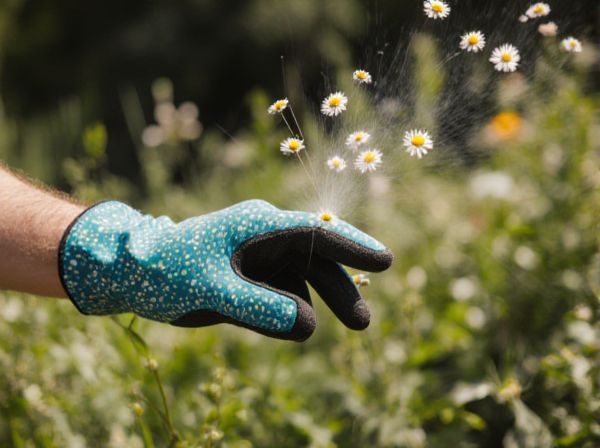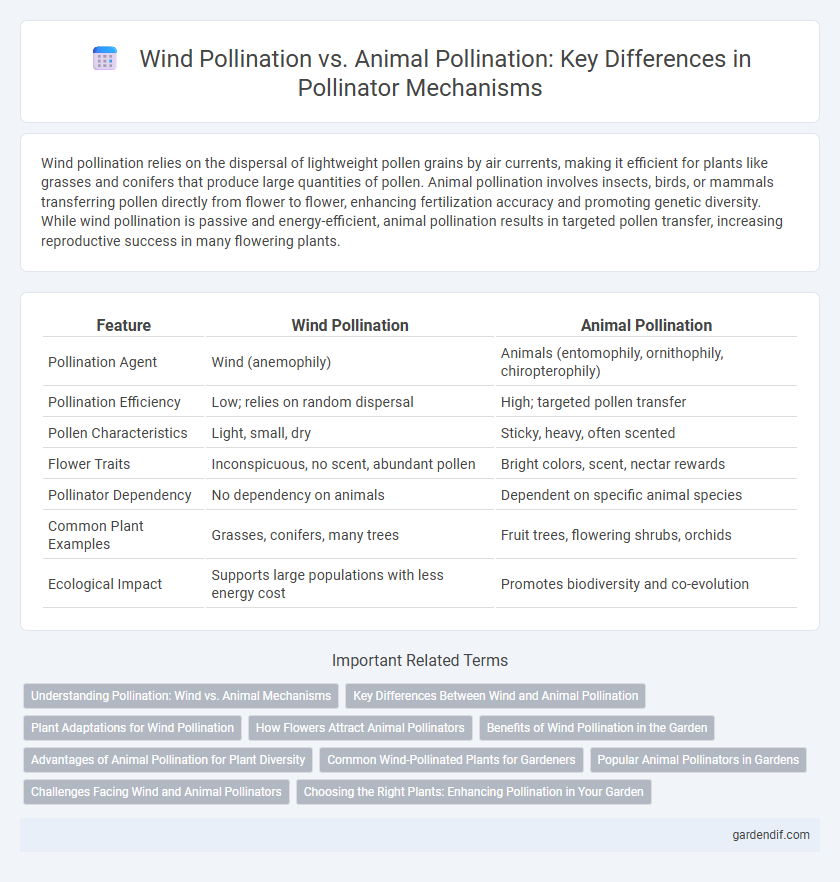
Wind Pollination vs Animal Pollination Illustration
Wind pollination relies on the dispersal of lightweight pollen grains by air currents, making it efficient for plants like grasses and conifers that produce large quantities of pollen. Animal pollination involves insects, birds, or mammals transferring pollen directly from flower to flower, enhancing fertilization accuracy and promoting genetic diversity. While wind pollination is passive and energy-efficient, animal pollination results in targeted pollen transfer, increasing reproductive success in many flowering plants.
Table of Comparison
| Feature | Wind Pollination | Animal Pollination |
|---|---|---|
| Pollination Agent | Wind (anemophily) | Animals (entomophily, ornithophily, chiropterophily) |
| Pollination Efficiency | Low; relies on random dispersal | High; targeted pollen transfer |
| Pollen Characteristics | Light, small, dry | Sticky, heavy, often scented |
| Flower Traits | Inconspicuous, no scent, abundant pollen | Bright colors, scent, nectar rewards |
| Pollinator Dependency | No dependency on animals | Dependent on specific animal species |
| Common Plant Examples | Grasses, conifers, many trees | Fruit trees, flowering shrubs, orchids |
| Ecological Impact | Supports large populations with less energy cost | Promotes biodiversity and co-evolution |
Understanding Pollination: Wind vs. Animal Mechanisms
Wind pollination relies on the movement of pollen grains through air currents to fertilize plants like grasses and conifers, requiring large quantities of lightweight pollen due to its random dispersion. Animal pollination involves biotic agents such as bees, butterflies, and birds, which transfer pollen more efficiently by targeting flowers with specialized adaptations like nectar rewards and vibrant colors. Understanding these mechanisms highlights differences in evolutionary strategies, pollen structure, and plant reproductive success rates across ecosystems.
Key Differences Between Wind and Animal Pollination
Wind pollination relies on the dispersal of lightweight, non-sticky pollen by air currents, predominantly seen in grasses, conifers, and many trees, whereas animal pollination involves biotic vectors such as bees, birds, and bats transporting heavier, often sticky or barbed pollen. Flowers adapted for wind pollination are typically small, inconspicuous, and produce large quantities of pollen to increase the chance of successful pollination, while animal-pollinated flowers are usually bright, fragrant, and produce nectar to attract pollinators. The efficiency of animal pollination is generally higher due to targeted pollen transfer, contrasting with the random and often wasteful process of wind pollination.
Plant Adaptations for Wind Pollination
Plants adapted for wind pollination often have small, lightweight, and abundant pollen grains to maximize dispersal efficiency through air currents. They typically exhibit reduced or absent petals, lacking bright colors and scents, since attracting animals is unnecessary for pollen transfer. Flexible and exposed stamens and pistils increase pollen release and capture, optimizing reproductive success in open, windy environments.
How Flowers Attract Animal Pollinators
Flowers attract animal pollinators through vivid colors, enticing scent compounds, and nectar rewards that signal food sources. Specialized floral structures, such as landing platforms and tubular shapes, facilitate access for specific pollinators like bees, butterflies, and hummingbirds. These adaptations enhance pollination efficiency by encouraging repeated visits and ensuring pollen transfer between conspecific plants.
Benefits of Wind Pollination in the Garden
Wind pollination benefits gardens by enabling the fertilization of plants without reliance on animal activity, reducing vulnerability to fluctuations in pollinator populations. It facilitates the effective pollination of grasses, trees, and many crops, promoting biodiversity and enhancing seed production. Wind-pollinated plants typically require less maintenance and attract fewer pests, contributing to sustainable garden management.
Advantages of Animal Pollination for Plant Diversity
Animal pollination enhances plant diversity by enabling precise pollen transfer between flowers, increasing cross-pollination rates and genetic variation. Pollinators such as bees, butterflies, and birds can navigate diverse floral structures, promoting reproduction in species that wind pollination cannot effectively reach. This targeted mechanism supports ecosystem resilience and the survival of specialized plant species with complex reproductive strategies.
Common Wind-Pollinated Plants for Gardeners
Common wind-pollinated plants for gardeners include grasses, many tree species such as oak and birch, and certain vegetables like corn and spinach. These plants rely on lightweight, airborne pollen grains dispersed by wind currents rather than animal vectors. Gardeners cultivating wind-pollinated species should ensure optimal spacing and minimal barriers to airflow to maximize pollination success.
Popular Animal Pollinators in Gardens
Bees, butterflies, and hummingbirds are the most popular animal pollinators in gardens, playing a crucial role in the fertilization of flowering plants. These pollinators transfer pollen efficiently due to their frequent visits to various flowers, enhancing biodiversity and crop yield. Unlike wind pollination, which relies on random pollen dispersal, animal pollination ensures targeted pollen delivery, increasing the success rate of plant reproduction.
Challenges Facing Wind and Animal Pollinators
Wind pollination faces challenges such as dependence on unpredictable wind patterns and the production of large quantities of pollen to ensure fertilization. Animal pollinators encounter threats from habitat loss, pesticide exposure, and climate change, which reduce their populations and disrupt pollination services. Both methods are crucial for ecosystem balance but face increasing environmental pressures that impact plant reproduction.
Choosing the Right Plants: Enhancing Pollination in Your Garden
Selecting plants with traits suited for wind pollination, such as lightweight pollen and exposed stamens, maximizes efficiency in gardens relying on air currents. Incorporating animal-pollinated species with vibrant flowers and nectar rewards attracts bees, butterflies, and birds, boosting biodiversity and pollination rates. Balancing both types by choosing a diverse mix of wind- and animal-pollinated plants enhances fruit set and overall garden productivity.
Wind Pollination vs Animal Pollination Infographic

 gardendif.com
gardendif.com